In the winter season of cold, snow and holiday music, the North American bird breeding and nesting season seems months away. It’s not until the trees begin to bud and flowers bloom that the birdsong fills the air.
And that’s true. But not for great horned owls.
Winter is the time to enjoy the great horned owl breeding season–a time when these charismatic birds are much easier to see and hear.
It’s the hooting season.
Don a winter cap and head out to your local park or walking trail to enjoy one of the season’s coolest spectacles. Here’s what you need for your next owl outing.
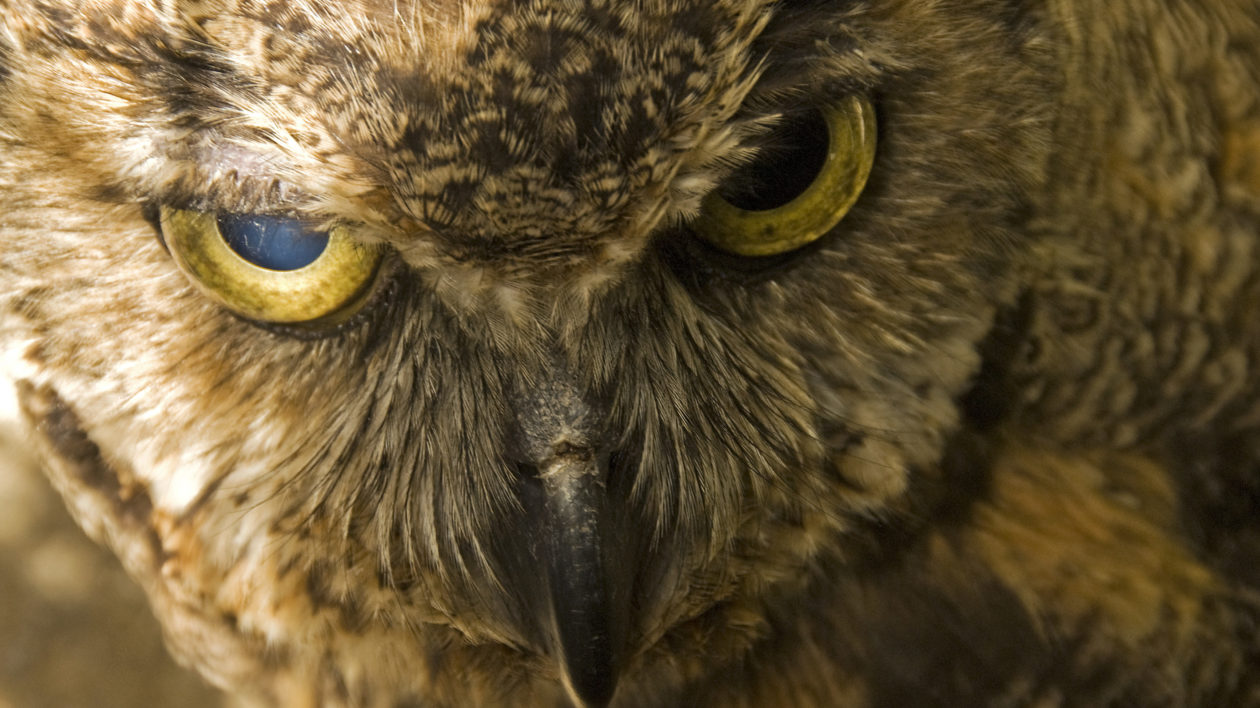
Into Owl Territory
The great horned owl, of course, is one of the most recognizable birds in the Americas, with its pointy feather tufts (the “horns”) and large fluffy appearance.
This is the prototypical “wise old owl,” and the owl of cartoons and children’s books.
It’s also incredibly adaptable, found from Canada to Patagonia, and most places in between. It is at home in desert and wetland, forest and prairie. And it also has no trouble thriving around people: you can find them in parks, farms, small woodlots, suburbs and cities.
Despite this, they’re not always easy to spot due to their nocturnal habits. But at this time of year, in the right location, a chorus of hoots provides the soundtrack to dawn and dusk.
That’s because, around October, male great horned owls begin setting up territories. Most great horned owls mate for life, but in the fall the pair begin a courtship display, loudly calling to each other.
Become a Member
Make a lasting impact for nature when you join The Nature Conservancy
The great horned owl’s hoot is pretty much unmistakable, although ornithology web sites often describe it in different ways. A common hooting pattern is a longer hoooooot, followed by two or three shorter hoots.
And these owls have a range of other vocalizations, too, some of which sound like barks or a screeching cat. (Cornell’s All About Birds site features some great audio of these different calls).
The owls continue setting up their territory this month, and begin setting up a nest.
They’ll use an abandoned nest previously used by a red-tailed hawk, squirrel or other critter. Come January, they’ll begin setting in the nest–far earlier than most other birds.
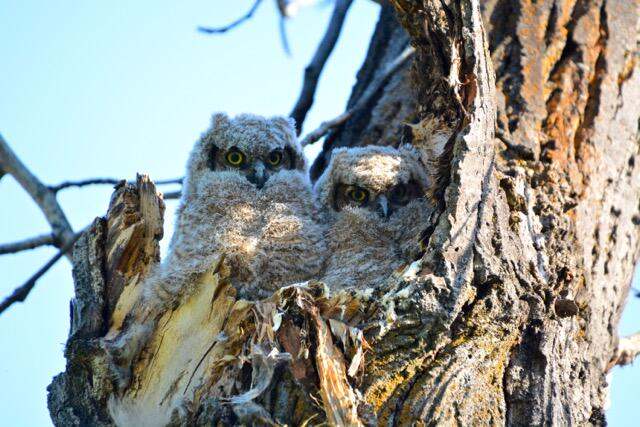
Why Do Owls Nest So Early?
Nesting early naturally entails some risk. Eggs must be kept warm and incubated, which can be a challenge when the temperature is in the single digits and snow is falling.
Female owls stay on the nest for prolonged periods (and when they leave to hunt, the male will take over).
If the eggs become too cold, they won’t hatch. This is why most birds wait until temperatures are warm and mild.
So: why nest early?
Owls are large birds. It takes them longer to grow and mature than, say, a songbird.
Young great horned owls must also master complex hunting maneuvers. They are equipped with superb senses – researchers have found that a great horned owl can hear a mouse rustling at 900 feet – but hunting still involves learning, trial and error.
Early hatching means they’re ready to practice their flying and hunting skills when the weather is mild and prey is abundant.
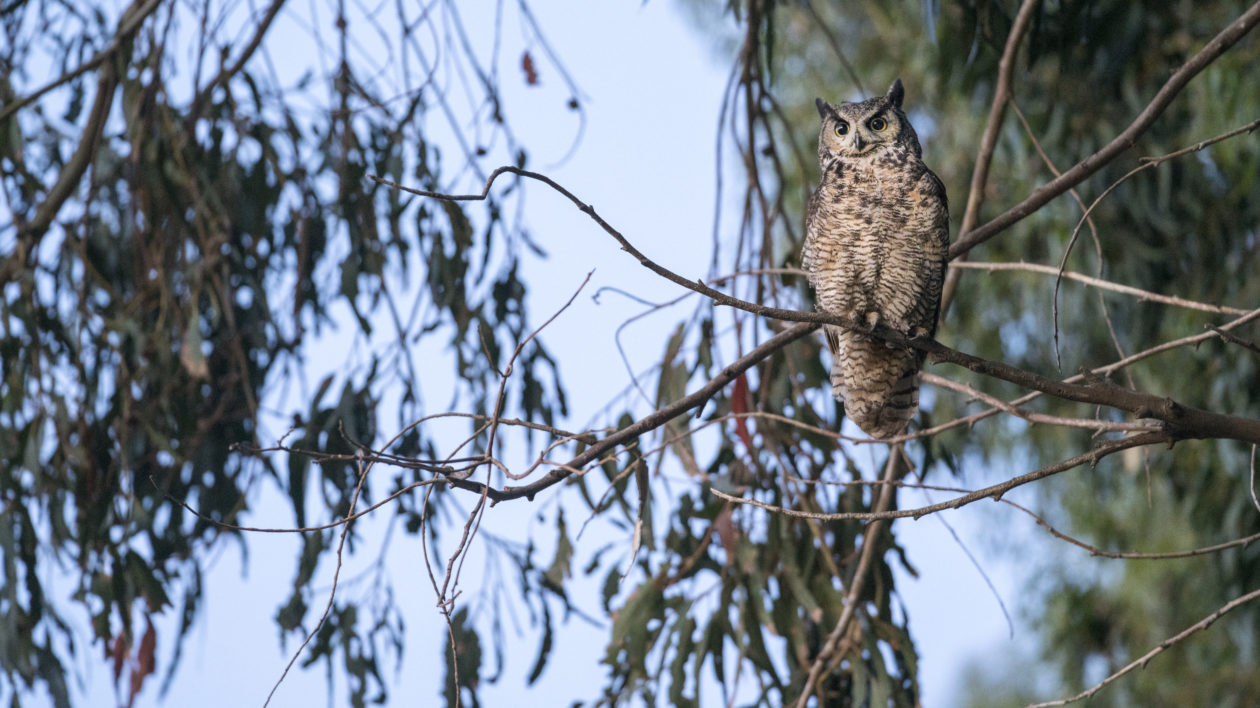
Enjoying the Owl Show
There’s likely a great horned owl territory near you. Now you just need to find it.
While owls can live in a variety of habitats, you won’t find them just anywhere. Focus on the edges. Owls prefer to have a good vantage point – a place where they can see out over the terrain.
Trees that overlook an open area are ideal. In particular, try to find a big-limbed tree that has shed its leaves (or a dead one). You can often find owls roosting there.
You can do a bit of scouting, too. Owls regurgitate the indigestible hair and bones of their prey: called owl pellets. You can often find a number of these pellets below preferred trees. (You can often reassemble the bones of mice by dissecting an owl pellet, another fun wintertime activity).
Of course, the easiest way to spot owls is not by looking, but listening. Those haunting hoots carry a long way. Sometimes you almost feel those hoots before you see them.
Once you hear the hooting, look carefully in likely trees, and you may be able to see the distinctive profile of the owl. Look through a binocular, and don’t be surprised if the owl is staring back at you.
It pays to quietly observe the owls for a while. I’ve been able to watch some interesting behavior, including owls mating.
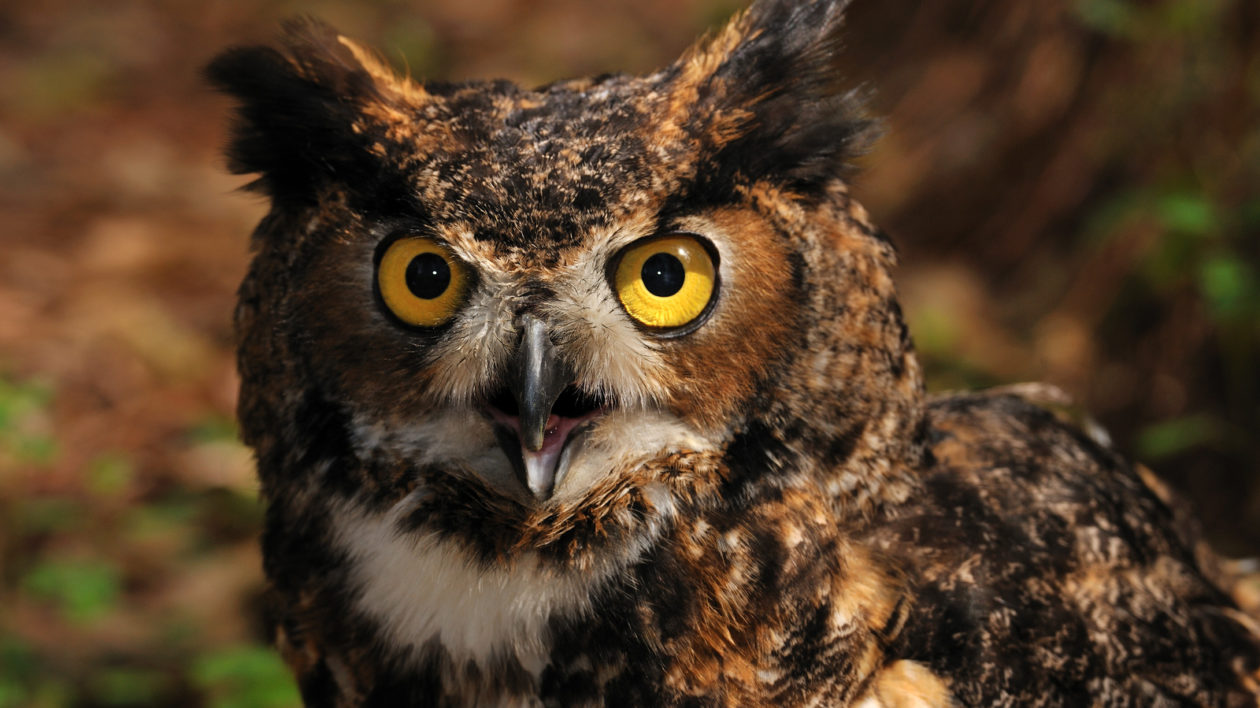
Photo © Mark Conlin, courtesy of Tallahassee Natural History Museum
My Owl Connection
Family lore holds that, long before I could utter words, I would lie in my crib and hoot like an owl. Perhaps my naturalist path was set, even then.
That story has been in my thoughts this year, as I prepare for the birth of my own son. The great horned owls, it seems, are everywhere. I see them perched on trees around our home and along the greenbelt jogging path; hear their calls in the canyons and river bottoms.
I’m always alert to the local wildlife, but this year, I can’t help but pay extra attention to all that owl activity.
I wake up in the middle of the night, thinking of my son and the world he’ll inhabit. And then, there it is: that deep hoot, hoot, hooting.
It seems to fill the room.
I snuggle under the covers and smile, filled with the hope that my son will find such comfort and joy in the wild things and their always-interesting ways.
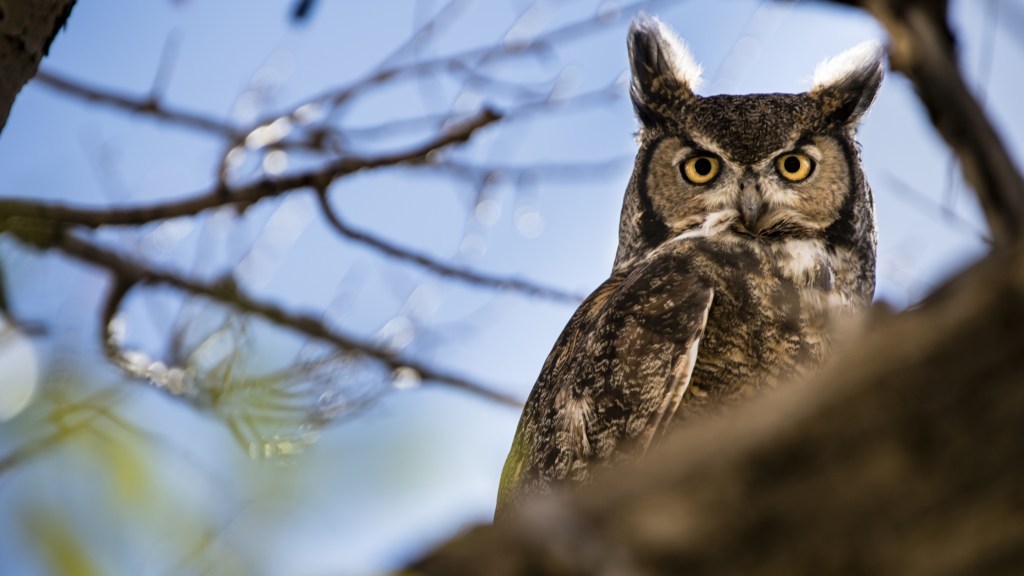



I have a Mr and Mrs owl in my tree outside my window. They like to sit next to each other.
I can’t imagine they will mate? How can they ever do it?
There is no nest in my yard so not sure where they will find one.
I did wonder about something I saw below my tree like a little gray bundle. Now you answered my question about what it was.
I am really interested in watching my owls.
Enjoy your site and all the wonderful info you post. Thank you.
Since about August (2019) we have had the wonderful pleasure of having two great horned owls in a mesquite tree in our walled-in back yard – a smallish enclosure on 3.5 acres. I assume they are male and female. They don’t seem to mind when I water my plants or hang clothes on my clothesline strung between two mesquites. I say a few words to them.
One morning I had trouble figuring out what I was seeing as I looked up at the large owl. It was the back half of a rabbit, and I was seeing the hind legs hanging down. The owl munched on it much of the day , and I collected two owl pellets for neighbor’s grandson to “explore.”
At times the two sit side by side. At times one is on a limb above the other. Other times they are in different areas of the mesquite. I will be forlorn when they are no longer around, as I “check” on them several times a day. Owls are a new and lovely experience for me, here in the Arizona-Sonora Desert, Tucson. 10-16-19
My wife and I love sitting on our back porch having coffee early in the morning….and listening to the owls communicate with each other about where they’re going to hunt tonight, or perhaps calling on potential mates ? but this morning (8/31/19) was special. No fewer than five distinct “hoots” or calls were heard in the woods at the end of our cul-de-sac…in our Central Virginia Subdivision! We love listening to the sound of the various birds – even though we can’t see them! A great way to begin our Saturday morning I think!
We have had a pair of great horned owls on our farm for over 20 years. Recently one of the pair was killed after flying into a fence. What will happen to the survivor? Will it stay around, look for another mate, or grieve and pass away? I live in Kentucky.
Thanks!!
Lots of them here in AZ. A pair have been nesting for 22 years in the neighbors tree in their back yard. We see them every day. One year there was 3 babies. One baby this year. A couple of weeks ago, I found one of them in our pool drowned. I am so sad. My question, will the remaining bird find a new mate? It is still feeding the young bird. I have a beautiful picture of the pair.
We had a Great horn nest in one of tall trees , We watched and took photo, w
When her ends hatched, we herd chick sounds. One day we saw a chick corset out of nest and it could not get back, Mom was goon the chick fell trying to get back in nest. It was 65 ft drop and it did not live. Bent day. another chick was out of nest but it managed to get back.- Mom got a stray cat ot pet for food. It was big and it lade across the nest. Did not see chicks again but heard them. Then crow came and the atom mom keep leading them away from nest. This went on for two days. The a neibor started mowing and mom move away. She flew south and goon for hours. Next day the Ded cat and chicks were goon!
Did she move ther ? To a place with less noise ? will the Great horn owl do this?
Would have loved watching then grow,
Dante and Patti, south OK / Texas border
Hello i live in Bellingham WA about 20 minutes from Canada.
over the last few months i have been lucky to hear hooting coming from a few different tees on my block.
at first i thought it was a large group of owls, but after some research i have learned that it is more likely a pair of great horned owls. calling back and fourth to each other.
one has a deeper hoot than the other. they are usually very hooty around 4 am.
the sound is deep and awesome. i can actually feel the hahhhoo hoot!
its nice to know Im not the only night owl in my neighborhood.
I live in Fairbanks, Ak. I have been enjoying hearing what I believe to be, great horned owls the last two weeks, early in the morning.
I’ve been hearing hooting by my house and I put up i-ness for them hoping that they will come to it
Hi Matthew, my name is Victor Haynes and I live in Kitty Hawk, N.C. My home is near the Kitty Hawk Woods Preserve and only miles from The Nature Conservancy Nags Head Woods. Last night Great Horned owls were hooting it up near my home. It is always a thrill for me as well. This morning I set out to look for signs of them to no avail but having read your article I now know more of what to look for. Keep up the good work and congratulations. Regards, Victor
I live in the country now and have a wooded area behind my house. There was a pair of Great Horned owls calling to each other about 4:30 this morning. Very close. With all there is to worry about in the artificial world we have created for ourselves it was a reassuring sound of nature.
Is it true that it is bad luck to see an owl in the daytime? I saw one today at 9:00 A.M. on our roof, not moving muscle. He was just staring at the ground. It was broad daylight. It was very strange.
We had a mating pair of great horned owls in our Arizona Mobile park for a few years. Last year I believe something happened to one of them early in the season so there was no nesting activity. We were lucky enough to capture many previous pics from 2 years before and the pair successfully raised 3 young. The last 2 weeks an adult owl has been hooting at dusk and again at dawn. He or she perches in the same area as 2 years ago leading me to believe it’s one of the senior owls. Is it safe to say that this magnificent bird will not mate again. It still hoots away at the old nesting tree, but have only seen 1 and thinking it will soon leave the area again like it did last year. Thanks and enjoyed this site for a great read.